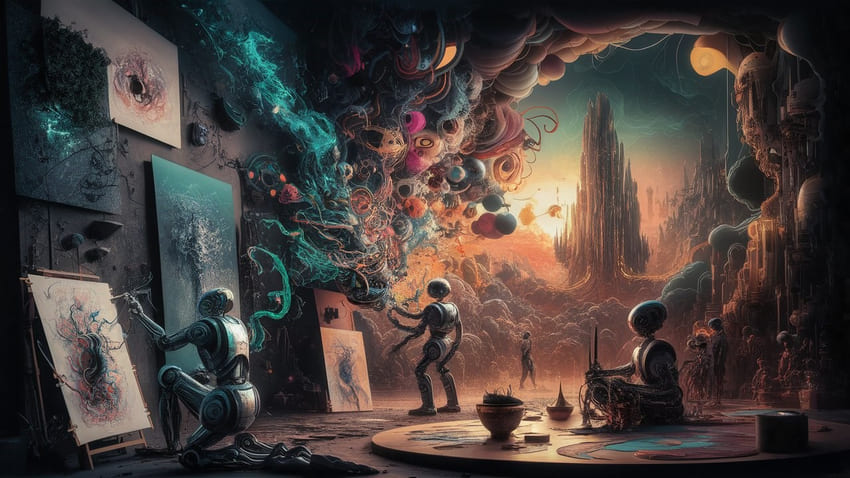
Augmenting Creativity: Opportunities and Challenges of AI Integration in Visual Arts
Title
Augmenting Creativity: Opportunities and Challenges of AI Integration in Visual Arts
Author
1. Jan Michael,
Student, University of the Philippines Diliman, Philippines
2. Paul Raymond,
Lecturer, University of the Philippines Diliman, Philippines
Abstract
Artificial Intelligence (AI) has emerged as one of the most transformative technologies of the 21st century, profoundly reshaping the landscape of visual arts. With the rapid advancement of generative systems—ranging from Generative Adversarial Networks (GANs) to diffusion models and multimodal large language models—AI is now capable of producing visual outputs that rival human artistry in complexity, coherence, and creativity. Unlike prior technological shifts such as photography or digital editing, which extended existing practices, AI introduces entirely new modes of image creation, challenging long-standing assumptions about creativity, authorship, and cultural value.
This paper provides a comprehensive analysis of AI integration in visual arts, adopting a framework that treats AI not as a replacement for human creativity but as a co-creative agent in hybrid artistic production. Drawing from recent scholarship and practical examples, the study explores both opportunities and challenges of this transformation. On the one hand, AI democratizes access to art-making, accelerates creative workflows, fosters interdisciplinary practice, and generates novel aesthetic forms. On the other hand, it raises pressing questions about intellectual property, ethical use of training data, cultural homogenization, and the loss of human intentionality.
Through literature review, detailed case studies—including Archive Dreaming by Refik Anadol, Portrait of Edmond de Belamy, and Zarya of the Dawn—and an analysis of system architectures underpinning AI-driven creativity, this paper critically evaluates how AI alters artistic processes, pedagogical models, and market dynamics. The findings suggest that while AI augments human imagination in unprecedented ways, responsible frameworks for authorship, cultural preservation, and ethical governance are urgently needed.
Keywords
Conclusion
AI has become an indispensable yet contested force in visual arts. Its power to generate images, reinterpret archives, and democratize creativity signals profound shifts in cultural production. Case studies such as Anadol’s Archive Dreaming, Obvious’ Edmond de Belamy, and Kashtanova’s Zarya of the Dawn demonstrate both the possibilities and controversies of AI-assisted creativity.
The benefits are considerable: democratization, efficiency, expanded aesthetics, and new pedagogical tools. Yet the challenges are equally pressing: blurred authorship, ethical concerns, cultural homogenization, and loss of traditional skills. Ultimately, the integration of AI into visual arts calls for balance—embracing its potential to augment human imagination while critically engaging with its risks.
As this paper argues, AI should be viewed not as a substitute for human creativity but as a co-creative partner that extends the boundaries of artistic expression. The future of art will depend on how artists, institutions, educators, and policymakers negotiate this partnership, ensuring that technological innovation remains in service of human culture rather than in opposition to it.
Author Contrubution
The author handled all aspects of the study, including its design, data collection, analysis, and manuscript preparation.
Funding
No specific financial support from public, commercial, or non-profit funding agencies was received for this research.
Conflict of Interest
There are no conflicts of interest to report from any of the authors.
Data Sharing Statement
Not applicable.
Software And Tools Use
Not applicable.
Acknowledgements
I am grateful for the expertise and help provided by all who contributed to this study and manuscript, and for the comments from anonymous reviewers.
Corresponding Author
Jan Michael
University of the Philippines Diliman, Student, Philippines
Paul Raymond
University of the Philippines Diliman, Lecturer, Philippines
Copyright
Copyright: ©2025 Corresponding Author. This is an open access article distributed under the terms of the Creative Commons Attribution License , which permits unrestricted use, distribution, and reproduction in any medium, provided the original author and source are credited.
Michael, Jan, and Raymond, Paul. “Augmenting Creativity: Opportunities and Challenges of AI Integration in Visual Arts.” Scientific Research Journal of Arts, Humanities and Social Science, vol. 3, no. 1, 2025, pp. 70-76, https://isrdo.org/journal/SRJAHS/currentissue/augmenting-creativity-opportunities-and-challenges-of-ai-integration-in-visual-arts
Michael, J., & Raymond, P. (2025). Augmenting Creativity: Opportunities and Challenges of AI Integration in Visual Arts. Scientific Research Journal of Arts, Humanities and Social Science, 3(1), 70-76. https://isrdo.org/journal/SRJAHS/currentissue/augmenting-creativity-opportunities-and-challenges-of-ai-integration-in-visual-arts
Michael Jan and Raymond Paul, Augmenting Creativity: Opportunities and Challenges of AI Integration in Visual Arts, Scientific Research Journal of Arts, Humanities and Social Science 3, no. 1(2025): 70-76, https://isrdo.org/journal/SRJAHS/currentissue/augmenting-creativity-opportunities-and-challenges-of-ai-integration-in-visual-arts
2381
Total words1141
Unique Words124
Sentence18.508064516129
Avg Sentence Length0.33346998207885
Subjectivity0.052008928571429
PolarityText Statistics
Viewed / Downloads
Total article views: 227 (including HTML, PDF, and XML)| HTML | XML | Total | |
|---|---|---|---|
| 118 | 63 | 46 | 227 |
Viewed (geographical distribution)
Thereof 217 with geography defined and 10 with unknown origin.